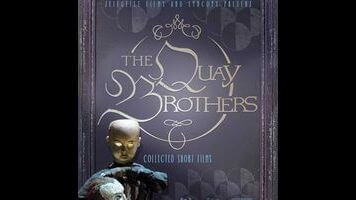A new Blu-ray anthology showcases the Quay brothers’ baffling brilliance

In “Quay,” a 10-minute documentary by Christopher Nolan about avant-garde animators Stephen and Timothy Quay, the Inception director tours the twin brothers’ studio, getting a good look at the grubby mirrors, vintage equipment, and curious props they like to use. He lets his own camera linger over the Quays’ hands, observing but not commenting on the brothers’ most important tools. And all the while, Nolan listens to the two talk. Even though the Quays were born and raised near Philadelphia—and have lived in England since moving there in 1969, in their early 20s—each speaks with a unplaceable accent that sounds part Irish and part German. They’re very articulate about what they do, both in Nolan’s documentary and in the half-dozen or so commentary tracks on the new Blu-ray set The Quay Brothers: Collected Short Films. But it only takes a minute or two of hearing Stephen and Timothy’s arcane allusions to experimental artists and half-forgotten folklore to realize that while they know what they mean, they’re never really going to explain their work. Nor should they.
Over and over in their commentary tracks, the Quays discuss their past experiences with organizations like the BBC and MTV, who’ve admired their talent but have wondered if maybe—just maybe—they could make something with a recognizable story. Instead, when they tackled The Epic Of Gilgamesh for their 1985 film “This Unnameable Little Broom,” they created something they called “a largely disguised reduction,” while in other shorts they’ve adapted “difficult” authors like Bruno Schulz and Stanisław Lem. Financial backers often ask to look at a script before the Quays start production, but it’s never done them much good. The brothers are going to do what they do, no matter how they pitch a project when they’re asking for money. It’d be mistake to ask them to anticipate—or even define—what’ll emerge from their subconscious.
Because of the nature of the Quays’ films, they’re hard to describe without just cataloguing their imagery. It’s not uncommon to lose all sense of time and conventional comprehension while watching something like 1984’s “The Cabinet Of Jan Svankmajer,” an homage to the Czech surrealist that gets more and more visually dense and recursive until it resembles a moving M.C. Escher painting. Though the Quays’ work has been compared to Svankmajer’s, they really have more of an affinity with David Lynch, Luis Buñuel, Maya Deren, and other live-action filmmakers who’ve dealt in dreamscapes and tactility. To put it another way: the likes of “Cabinet,” “Little Broom,” 1986’s “Street Of Crocodiles,” 1988’s “Rehearsals For Extinct Anatomies,” and 1990’s “The Comb” both invite and defy interpretation. It’s rewarding to try and pick through the symbolism of a misshapen creature cutting up and consuming dandelions, or a wire-beast caressing a squishy nipple-like bump on its forehead, or ladders thrusting their way up endless flights of stairs. It’s also worthwhile just to let those pictures burn their way into the brain, as singular works of art.
That said, The Quay Brothers: Collected Short Films does make the twins’ work more comprehensible, just by assembling so much of it. There are nearly four hours’ worth of films here, running the gamut from avant-garde classics like “Street Of Crocodiles” to more commercial(ish) efforts like the MTV bumpers and His Name Is Alive music videos that the Quays made in the 1990s. For the most part, their shorts have gotten more abstract since the 1980s, as evidenced by 2000’s “In Absentia,” a collaboration with composer Karlheinz Stockhausen that’s almost as minimalist as the music—all flickering light and animated pencil shavings. But they’ve also made films like 2003’s “The Phantom Museum” and 2011’s “Through The Weeping Glass,” which function as mini-tours through bizarre collections of medical oddities.
Really, it’s not too crazy to think of the whole Quay filmography as a series of illuminating documentaries: about old books, outsider art, archaic cultural phenomena, and the curiosities of the natural world. The brothers have certain visual motifs—rapidly vibrating objects, piles of dust, shattered dolls, and distorted extreme close-ups—that help clarify the way they see the world. But to unlock more about what they see, go straight to 1991’s “Anamorphosis” (a.k.a. “De Artificiali Perspectiva”), which is a relatively straightforward nonfiction piece about hidden messages and optical illusions in centuries-old paintings. The narration contains one line that could almost serve as a thesis statement for the Quays, saying, “An image grasped too quickly might not leave a lasting impression.” But just as key are the examples of the art itself, which looks plain at a direct angle and reveals secret faces and objects when looked at askew, through the right lens. The Quay brothers’ films never look straight ahead.